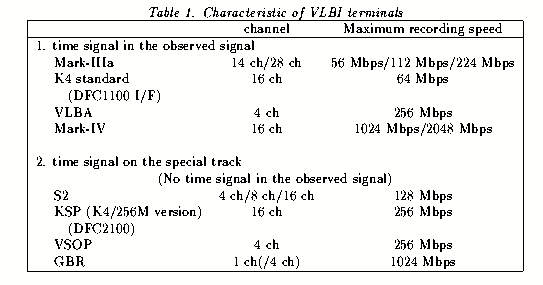
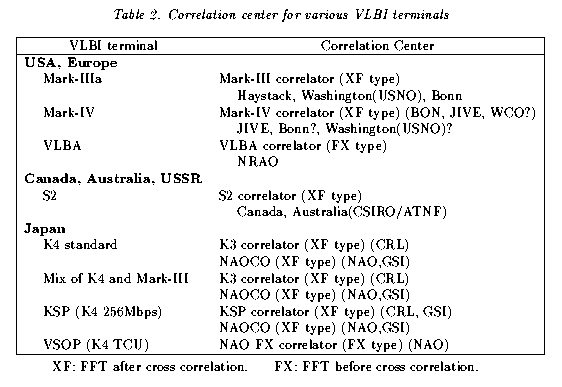
Kashima Space Research Center
Communications Research Laboratory
893-1 Hirai, Kashima, Ibaraki 314, Japan
I reported the compatibility of VLBI terminal in
TDC News No.9 in 1996, and
would you like to refer it.
The international VLBI observations have been conducted using Mark-IIIa VLBI terminal. The recording rates of the system are 56 or 112 Mbps /14 channels, and 112 or 224 Mbps /28 channels. The recording capacity is 1.1 Tb/tape. This is the standard VLBI system.
K4 and KSP system developed by CRL in Japan has been used for 64 Mbps, 128 Mbps and 256 Mbps/16 channels. The recording capacity is about 0.8 Tb/tape. The VSOP terminal is similar to K-4 system, but only 4 channels. Any operator for tape change is not necessary for 24 tapes. S2 VLBI terminal developed by Canada has used at 128 Mbps. It has 4 or 8 or 16 channels. The VLBA terminal developed by USA is 256 Mbps/4ch or 16ch is used in radio astronomy or geodetic VLBI. These three types of VLBI terminals are presently available.
Recently, Mark-IV which will be used for 1 Gbps (or /2Gbps ?) was developed in USA and the correlation center has been established in JIVE and other countries. Mark-IV is upward compatible with VLBA. CRL has developed a new VLBI terminal which is used for 1 Gbps/1 channel (or 4 channels?) mode to record on cassette tape. We call this the "GBR system". These terminals are considered to be a next generation VLBI terminal.
I summarize the characteristics of VLBI terminal in Table 1. It is divided
into two groups of recording format. One group records the time signal
in the observation signal. Another group records the time signal on
another track. The latter provides excellent time control.


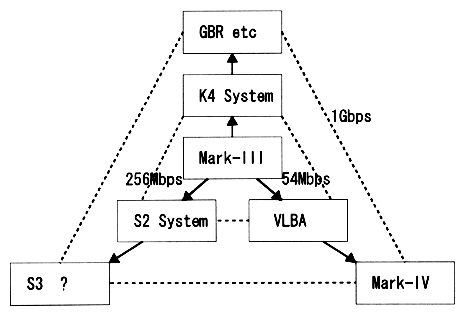
I represent two correlations; one is the correlation which mixes types of
terminals, and another is the correlation using next-generation VLBI terminals.
CRL succeeded in performing mixed correlation between K4 VLBI terminal and
Mark-III [Takahashi et al., 1995]. CRL also developed the first copying system
from the K-4 system to Mark-IIIa systems. Recently, the VSOP group at NAO has
developed a copying system between the different VLBI terminals of the VLBA, S2,
VSOP-K4 systems. Observations which mix the various VLBI terminals cannot be
available until the development of this system. Table 3 shows the copying
systems.
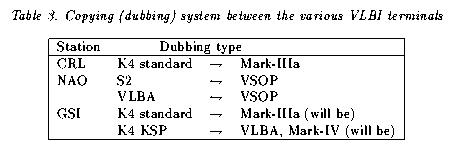

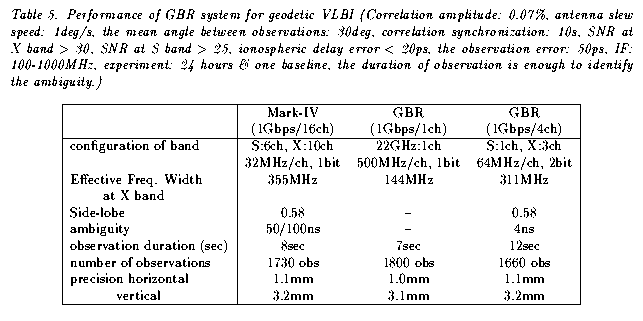
The correlation center of Mark-IV which is one of the next generation VLBI terminals will be JIVE in Europe. Bonn and others are planning for a Mark-IV correlation center. CRL has also developed the correlator for GBR which is the next generation VLBI terminal. It is for a single baseline, but observations of high sensitivity and wide bandwidth will be possible for astronomy. If GBR can perform correlation processing of 4 channels, then it is possible to use the GBR system for geodesy. Table 5 shows the performance of GBR system when used for geodesy in two cases: 1 channels in the 22 GHz band and 4 channels in the S and X bands.
Finally, we summarize the available VLBI terminals of stations in Japan.
In December 1996, the technical workshop for APT and APSG (TWAA96) was held at Kashima, CRL in Japan. These topics were discussed at this workshop and the different VLBI terminals were represented in the proceedings of the workshop. Please refer there for detailed information concerning VLBI terminal.